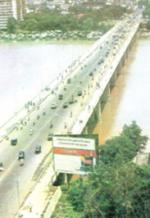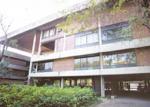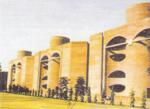This city does not live merely on the lost memories of the past glory and a historical museum. If its history is full of glory, so is its present. It is a constantly changing and lively city. That is why it never can be classed as a city facing diminished glory.The changing rule of the Solankis, Muslims and Mughals, Marathas and the English are digested, attacks bore and even absorbed well, and sometimes registering protests on its own, this city of Ahmedabad is always alive and as a city of constant effort, it has flourished all the while
Not just the ancient and medieval temples and mosques, mills and large mansions, the attractive modem constructions under the guidance of such expelis as Le Corbusier, Louis Kahn and Balkrishna Doshi also decorate this city. All this seems within the large yet handful land. While on one hand latest style of construction is undertaken, we find the descendants of the Sompuras continuing the age-old artistic style in the construction of several new Jain temples.
The people also seem to know how to enjoy themselves. The city is replete with latest facilities like the clubs of such dimensions as the Kamavati Club and Rajpath Club, several establishments catering cuisines from all over the world, number of hotels and modem theater complexes. In one building there are 4 to "6theaters, and facilities for shopping, bookshops, games, restaurants etc. The old mills are closed now but several other industries have come up. The trade activity "inold city areas like Richie Road, Relief Road, Ghee Kanta, Delhi Chakla, Ratan Pol, Dhalgarwad, Astodia and Raipur etc. are still as forceful as ever. The growing population however has spilled over onto the other side of the river. On that western side of the river again, the busiest roads, abuzz with commerce and traffic are Ashram Road and another named after a leading personality of the city, i.e. Chimanlal Girdharlal, or C.G. Road in short. These modern roads are broad and show off on both their sides most modern construction of a variety of buildings in which all sorts of activities are conducted. These include shopping malls, show rooms and eateries, small and big As if this was not sufficient, like an expanding octopus, Ahmedabad city has now begun to expand in all eight directions and corners that were once desolate. Bapunagar, Naroda, Asarva and Gomtipur have increased in size, and in Vatva the industries are expanding by leaps and bounds. In Vastrapur direction innumerable high-rise and multistoried buildings are mushrooming. The city has expanded in the direction of Ranip too. The wealthy section of the population delights in spending their weekends and vacation or holidays at a farmhouse in distant Bopal or similar places around the city. The original skyline of Ahmedabad with the Chimneys of mills is rapidly changing, and is replaced by the tall modern buildings dotting the various new roads encircling the evergrowing periphery. All buildings show television antennas and air conditioners; not just electric and telephone wires, but even t.v. cable wires crisscross above the residential buildings.
The 21st century has arrived in Ahmedabad. The computers have appeared long ago. At almost every corners we have Cyber Cafes, nearly all homes boast of PCs, even ordinary people have learned to communicate on e-mail and use ofInternet. Ordinary citizens can use their cell phones with aplomb. Cars of every de~cription appear on its roads, the roads are broad or becoming broad, under-bridges or over-bridges and malls similar to those in the V.S. no longer surprise the ordinary people, as these are also mushrooming. Shopping for everything under-one-roof is the latest mantra of civil development here is evident.
The horse carts have turned antique pieces in Ahmedabad. A groom with taste, or a person joining the lain religious ascetic order, or a very revered religious holy man can still be seen riding in a decorated horse drawn carts. But most common means of transport is the two-wheeler, auto-rickshaws and variety of luxury cars
For many years the river had not flowed from bank to bank except during some good days of the rainy season. However, the Narmada Yojana has made this possible for Sabarmati even during summer as the former river's waters are now diverted by man-made Sardar Patel Dam into Sabarmati. This has made it possible to remove the huts encroaching on its shores and in winter no longer the tents of a Circus are set up in it. There are 5 bridges across the river joining the two parts of the city and at night the headlights of vehicles make it look like a game of lights on the run
So much is changing in this city! And yet the traditions are keeping up with the modernity too, it seems. All seem to live hand in hand one can say.
To illustrate on the roads of the city we can see the camel carts and even elephants moving with ease with the latest car models. If you take a round of Khadia, Raipur, Ratan Pol, Dariyapur and Delhi Chakla you find the flavor of the old lifestyle of Ahmedabad still being practiced. Those living here continue to enjoy the 'fafda-jalebi, the delicacies ofChandravilas hotel; they flock to Raipur for fried delicacy of 'bhajias', or to Khadavala 'dalwadas', to look for 'chavanas' of old Sherbazar shops, to Manek Chowk for 'puri pakodi', to Janata for 'kulfi' with the same relish as in olden days. The elderly ladies of Ellis Bridge area do not wear the traditional saris; they don Punjabi dress of salvar and km1a. The dress of the college going boys is mostly jeans and of girls in their teens the pants. The bicycle is the vehicle of the poor, and rich boys zoom around in latest cars while rich girls roam like butterflies on their two wheelers. These kids do not like the traditional delicacies of 'fafda-jalebi' or 'bhajias' any more. They prefer burgers and pizza, bhajipao, Chinese and Mexican dishes. They consume loads of ice creams of great variety, juices and colas and shakes. A pizza may cost as much as Rs. 400, but is a hot favorite. Some restaurants do not serve anything but Salads! The eateries of roadside may serve one or more of these preparations and the youngsters flock here as their elders did for other items earlier. Preparations of omelet and 'dabeli' are some of the fast foods they love to consume by loads
There is a lot of change in the spoken Gujarati language too. The new generation is blindly determined to educate their young in English medium. The number of people who speak only in Gujarati is reducing day by day. Those who teach in Gujarati medium is also decreasing alarmingly. The new generation can hardly speak pure Gujarati; they speak it with a mixture of English words. This new language is now known as 'Gujinglish' ! The schools teaching in English medium are fast outnumbering those that teach through Gujarati medium. The childhood of the new generation is being sacrificed in this race to learn English; it does not know its own culture and cannot identify with the one he is taught. It has no inkling about the rich legacy of its Mother tongue and glorious Gujarati literature
Although the winds of change are sweeping over Ahmedabad, it has preserved much of its heritage too. The festivals such as 'Balev', 'Uttarayan', 'Janmashtami', 'NavratIi' and 'Diwali' are celebrated with the same old enthusiasm. The worship of Holi sees the sacred fire lit at each crossroad, the skies are full of all types of kites on Utran, and people enjoy traditional dishes on these days too
Within the city of Ahmedabad there are four local Universities: Gujarat University, lndira Gandhi Open University, Agriculture University and Gujarat Vidyapith. Besides, there are several modern educational and research centers also. In Ahmedabad treatments are available in pIety in vaIious systems of medicines, like Allopathic, Ayurvedic, homeopathic, acupuncture, physiotherapy, nature cure, etc. Also there are some 'hadvaids' or bone setters, and 'bhuvas' or tantriks as well.
There are many places that provide a thrilling experience in Ahmedabad. But this one is quite different. When we walk along the banks of Sabam1ati towards its small tributary Chandrabhaga and bowing to the Samadhi of Rishi Dadhichi on our way further north, we land at the 'Gandhi Ashram.' But, no, its given name is Satyagraha Ashram. In footsteps of great men, we came to know one such in flesh and blood as Mahatma Gandhi. This land is where he set up his Ashram! !
We are totally awed as soon as we enter this place. Our hearts mellow, head bows in reverence: even every particle of the dust of this place feels so sacred! The main person in charge of the Gandhi Museum introduces us to each and every item on display in details and our mind begins to unfold the memories of the great man of the 20th century, a man who made unique contribution to world history and to whom the world bowed as a unique personality. This is his land!
This is that banyan tree under which Gandhiji made that inspiring speech before he undertook the 'Dandi March', an unprecedented movement of world history, and he declared, "Until I attain Swaraj (Independence), I shall not retum to this Ashram". He challenged the might British imperial power by picking up a little salt in this Movement -without any power, any army, any weapon or equipment with him. When this movement began, not many had faith in it. Some felt it to be ridiculous, some thought of it as a farce. But they, and the world too, observed in amazement how it shook up the entire country into awareness at one go, and shook the very foundation of the British hold on India! The seemingly weak group of people who accompanied him did not chant any war cries, but sang devotional songs as they progressed on foot, without any weapons of violence. Led by an old scraggy individual, it began to gradually and increasingly attract wonder, admiration, enthusiasm and faith. The change from a small group into a vast crowd of natives was nothing short of total amazement. This Dandi March changed History, changed the philosophy of War, and added the chapter of War Without Weapons! The sound and light show that is now arranged for the visitors at Sabarmati Ashram brings this event to life for all who witness it. The story of the Mahatma ends here in this show, and that is quite logical too. One must recall that the Mahatma had vowed not to return to this Ashram until Independence was achieved. And when Independence was indeed achieved ... the events of the time left him with no contentment or peace in heart or mind ... and so the greatest man of the century never returned to this Ashram again. Before such an opportunity could come, he left this world ...
He kept his vow of not returning to the Ashram until Independence was achieved. He did return but in the form of his ashes after the cremation of his body and the ashes merged with the waters of River Sabarmati.
Drive-In Cinema
The Drive-In Theater has given the name to this road and area around it, where it is located. This is a special open-air theater, called Sunset Drive In Theater. We can consider it a place worth seeing in Ahmedabad. We can see a film on a huge screen while sitting in or around a car here. It has a small enclosed theater too.
VISHALA
Another attraction, like Drive In Theater, is Vishala. Absolutely true to the beautiful Gujarati village scene in its ambience, it is a place where eating is a pleasure as against the shining and urban eatefies that throng the city. Items like 'khichdi', 'kadhi', bajra rotla' etc. are also largely of village cuisine. The waiters are in villagers' dresses. At night the use of lanterns rather than electricity lends additional charm. Seats are like those used in villages, small 'khatlas', the shows of puppets and 'madari' or conjurer also give great entertainment to children of the city.
Next to it, though within the premises is a unique 'Utensils Museum'. Here we can see the great variety of utensils, their shapes, sizes, uses, metal used in their making, etc. that were used by earlier generations in Gujarat. This imaginative museum is a result of an idea of Surendra Patel when he saw them being sold for their weight rather than their aliistic or historic value, and then melted down.










